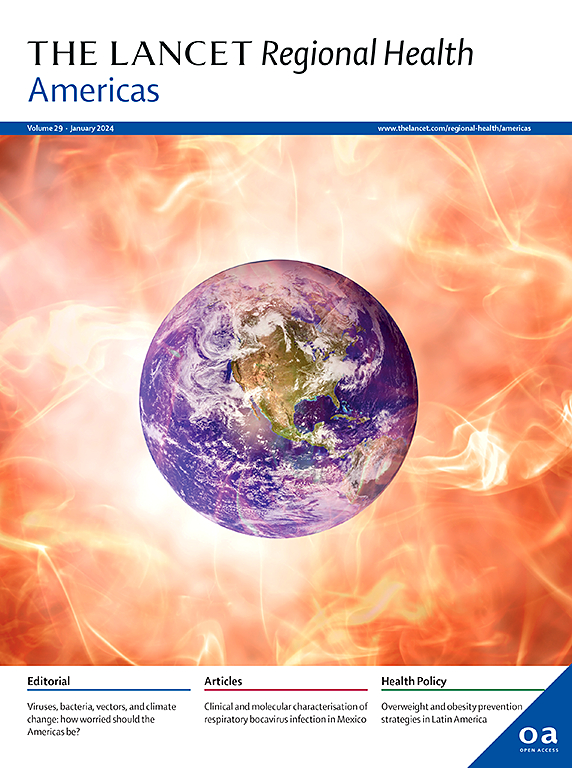阿根廷侵袭性肺炎球菌病:2018-2022年COVID-19大流行血清型、抗菌素耐药性和潜在影响回顾性观察研究概况
IF 7
Q1 HEALTH CARE SCIENCES & SERVICES
引用次数: 0
摘要
背景肺炎链球菌是发病率和死亡率的主要原因,在全球范围内构成重大的公共卫生威胁。本研究旨在描述阿根廷儿童和成人在covid前(2018-2019)和covid后(2021-2022)时期血清型分布、体外抗菌药物敏感性和侵袭性肺炎球菌疾病(IPD)频率的变化。方法开展了一项以实验室为基础的国家监测研究,分析了来自阿根廷侵袭性肺炎球菌病国家监测规划的1304株肺炎链球菌。根据年龄和血清型对分离株进行分层,并在适用的情况下评估抗菌药物敏感性。发现在2020年观察到分离株显著减少,随后从2021年开始再次出现,并在2022年达到峰值。过去5年儿童(5岁)中最流行的血清型包括3 (11%;54/494), 24f (8%;39/494), 19a (7%;35/494), 12f (6%;30/494)和14/23B (4%;20/494)。在成人(≥18岁)中,主要血清型为3 (17%;92/542), 8 (14%;76/542), 7f (5%;27/542), 9n (4%;22/542), 19A (4%;22/542)。值得注意的是,抗菌素耐药水平显著,儿童的耐药率(26%)高于成人(8%)。在PCV13血清型中,19A主要与多药耐药相关,而非PCV13血清型24在耐药菌株中普遍存在。血清型循环的波动,特别是在5岁以下儿童中,表明了covid -19后不断变化的动态。尽管尚不确定这些变化是否与大流行直接相关,还是反映了更广泛的趋势,但这些数据突出表明,迫切需要继续进行监测,并可能调整疫苗接种战略。本研究未收到任何资金。本文章由计算机程序翻译,如有差异,请以英文原文为准。
Invasive pneumococcal disease in Argentina: a snapshot from a retrospective observational study on serotypes, antimicrobial resistance, and the potential impact of the COVID-19 pandemic (2018–2022)
Background
Streptococcus pneumoniae is a leading cause of morbidity and mortality and poses a significant public health threat globally. This study aimed to characterise changes in serotype distribution, in vitro antimicrobial susceptibility, and the frequency of invasive pneumococcal disease (IPD) in paediatric and adult populations in Argentina during the pre-COVID (2018–2019) and post-COVID (2021–2022) eras.
Methods
We conducted a national laboratory-based surveillance study analysing 1304 S. pneumoniae isolates sourced from Argentina's National Surveillance Program for invasive pneumococcal disease. Isolates were stratified by age and serotype, with antimicrobial susceptibility evaluated where applicable.
Findings
A significant decrease in isolates was observed in 2020, followed by a resurgence beginning in 2021, peaking in 2022. The most prevalent serotypes in children (<5 years) over the past five years included 3 (11%; 54/494), 24F (8%; 39/494), 19A (7%; 35/494), 12F (6%; 30/494), and 14/23B (4%; 20/494). In adults (≥18 years), the leading serotypes were 3 (17%; 92/542), 8 (14%; 76/542), 7F (5%; 27/542), 9N (4%; 22/542), and 19A (4%; 22/542). Notably, antimicrobial resistance levels were significant, with children showing higher resistance rates (26% multidrug resistance) compared to adults (8%), Among PCV13 serotypes, 19A was predominantly associated with multidrug resistance, while non-PCV13 serogroup 24 was prevalent among resistant isolates.
Interpretation
The fluctuations in serotype circulation, particularly among children under five, suggest evolving dynamics post-COVID-19. Although it remains uncertain if these changes are directly linked to the pandemic or reflect broader trends, the data highlight an urgent need for continued surveillance and potential adaptations in vaccination strategies.
Funding
No funding was received for this study.
求助全文
通过发布文献求助,成功后即可免费获取论文全文。
去求助
来源期刊

Lancet Regional Health-Americas
Multiple-
CiteScore
8.00
自引率
0.00%
发文量
0
期刊介绍:
The Lancet Regional Health – Americas, an open-access journal, contributes to The Lancet's global initiative by focusing on health-care quality and access in the Americas. It aims to advance clinical practice and health policy in the region, promoting better health outcomes. The journal publishes high-quality original research advocating change or shedding light on clinical practice and health policy. It welcomes submissions on various regional health topics, including infectious diseases, non-communicable diseases, child and adolescent health, maternal and reproductive health, emergency care, health policy, and health equity.
 求助内容:
求助内容: 应助结果提醒方式:
应助结果提醒方式:


